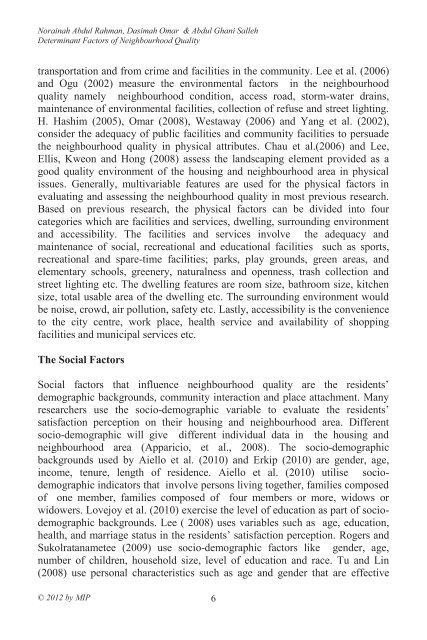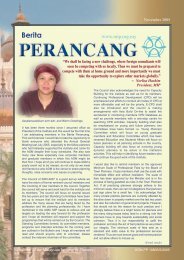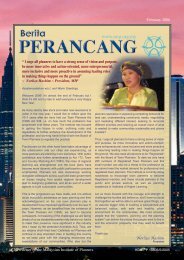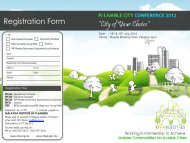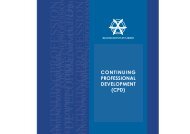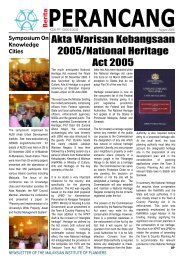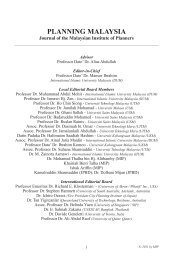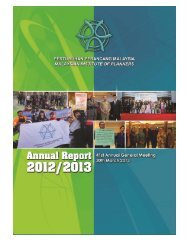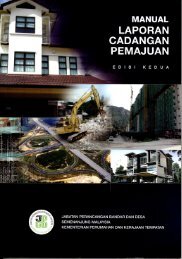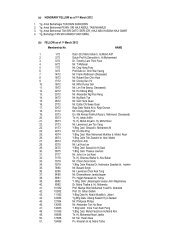Untitled - Malaysian Institute of Planners
Untitled - Malaysian Institute of Planners
Untitled - Malaysian Institute of Planners
Create successful ePaper yourself
Turn your PDF publications into a flip-book with our unique Google optimized e-Paper software.
Norainah Abdul Rahman, Dasimah Omar & Abdul Ghani SallehDeterminant Factors <strong>of</strong> Neighbourhood Qualitytransportation and from crime and facilities in the community. Lee et al. (2006)and Ogu (2002) measure the environmental factors in the neighbourhoodquality namely neighbourhood condition, access road, storm-water drains,maintenance <strong>of</strong> environmental facilities, collection <strong>of</strong> refuse and street lighting.H. Hashim (2005), Omar (2008), Westaway (2006) and Yang et al. (2002),consider the adequacy <strong>of</strong> public facilities and community facilities to persuadethe neighbourhood quality in physical attributes. Chau et al.(2006) and Lee,Ellis, Kweon and Hong (2008) assess the landscaping element provided as agood quality environment <strong>of</strong> the housing and neighbourhood area in physicalissues. Generally, multivariable features are used for the physical factors inevaluating and assessing the neighbourhood quality in most previous research.Based on previous research, the physical factors can be divided into fourcategories which are facilities and services, dwelling, surrounding environmentand accessibility. The facilities and services involve the adequacy andmaintenance <strong>of</strong> social, recreational and educational facilities such as sports,recreational and spare-time facilities; parks, play grounds, green areas, andelementary schools, greenery, naturalness and openness, trash collection andstreet lighting etc. The dwelling features are room size, bathroom size, kitchensize, total usable area <strong>of</strong> the dwelling etc. The surrounding environment wouldbe noise, crowd, air pollution, safety etc. Lastly, accessibility is the convenienceto the city centre, work place, health service and availability <strong>of</strong> shoppingfacilities and municipal services etc.SSocial factors that influence neighbourhood quality are the residents’demographic backgrounds, community interaction and place attachment. Manyresearchers use the socio-demographic variable to evaluate the residents’satisfaction perception on their housing and neighbourhood area. Differentsocio-demographic will give different individual data in the housing andneighbourhood area (Apparicio, et al., 2008). The socio-demographicbackgrounds used by Aiello et al. (2010) and Erkip (2010) are gender, age,income, tenure, length <strong>of</strong> residence. Aiello et al. (2010) utilise sociodemographicindicators that involve persons living together, families composed<strong>of</strong> one member, families composed <strong>of</strong> four members or more, widows orwidowers. Lovejoy et al. (2010) exercise the level <strong>of</strong> education as part <strong>of</strong> sociodemographicbackgrounds. Lee ( 2008) uses variables such as age, education,health, and marriage status in the residents’ satisfaction perception. Rogers andSukolratanametee (2009) use socio-demographic factors like gender, age,number <strong>of</strong> children, household size, level <strong>of</strong> education and race. Tu and Lin(2008) use personal characteristics such as age and gender that are effective© 2012 by MIP 6


